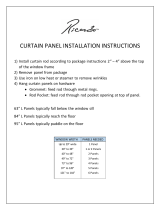
Doc No. 702111 Page 11 of 28
5. Wiring Details cont.
5.1 Burner controls
The burner controls are mounted in the burner
control cubicle which is an integral part of the air
curtain casing and are accessible by opening a
hinged lid on the right hand side of the air
curtain (see Figs. 4 and 5 in section 8 of this
manual for details). The controls accessible in
the cubicle are: gas solenoid valve, ignition
controller, air pressure switch, flame probe,
ignition electrode, reset switch, red and amber
neon lamps, plus associated wiring harness. For
details see burner wiring diagram in section 5,
page 9.
5.2 Control panel.
The electrical control panel incorporates the
facility to interlock with the door opening
mechanism and automatically switch the air
curtain between high/low speed as the door is
opened and closed. A pair of volt free auxiliary
contacts are required on the door open/close
contactor which closes as the door opens. If this
is not available then a suitably positioned limit
switch and striker plate will need to be fitted to
the door.
The panel incorporates an auto/off/manual
selector switch, which, when in 'auto' mode
operates the air curtain in low speed via an
external room thermostat provided the door is
the down position. In the door up position the air
curtain operates in high speed and overrides the
room thermostat The 'manual' position overrides
the door interlock and thermostat, and the 'off '
position turns the air curtain off.
A cool/heat selector switch is also incorporated
which allows the air curtain to supply heated
air, or unheated ambient air.
The panel also contains a removable link on the
main terminal rail to allow the air curtain to be
switched on and off remotely via a BMS control
relay.
The panel may also be fitted with optional low
voltage (24V AC) relays for fire alarm/door
contact interlocks.
Regardless of the position of any of the above
switches, the main air fans must be running to
allow the burner to run.
5.3 Overheat protection.
In the event of any overheat condition there are
two thermal limit controls fitted inside the air
curtain. The controls are factory set and
non-adjustable. The self resetting (cycling)
control activates at 70ºC, and the manual reset
control at 96ºC. If either set point is reached, the
corresponding limit control will interrupt the
electrical power to the burner gas valve. The
burner will not relight until the limit control has
reset. The manual reset button is located on top
of the heater on the left hand side of the
thermostat cover and can be accessed after first
removing the dust cover. (See Figs. C and D).
These safety devices provide protection in the
event of an air distribution fan motor failure, or
lack of airflow due to restrictions. (For location
see section 8 Fig.29, and section 5 diagram 8,
burner controls wiring diagram).
Warning: never attempt to bypass the
thermal limit controls as hazardous
conditions could result.
Fig. C
Fig. D
A customer specific control panel wiring
diagram will be supplied with each air curtain

























